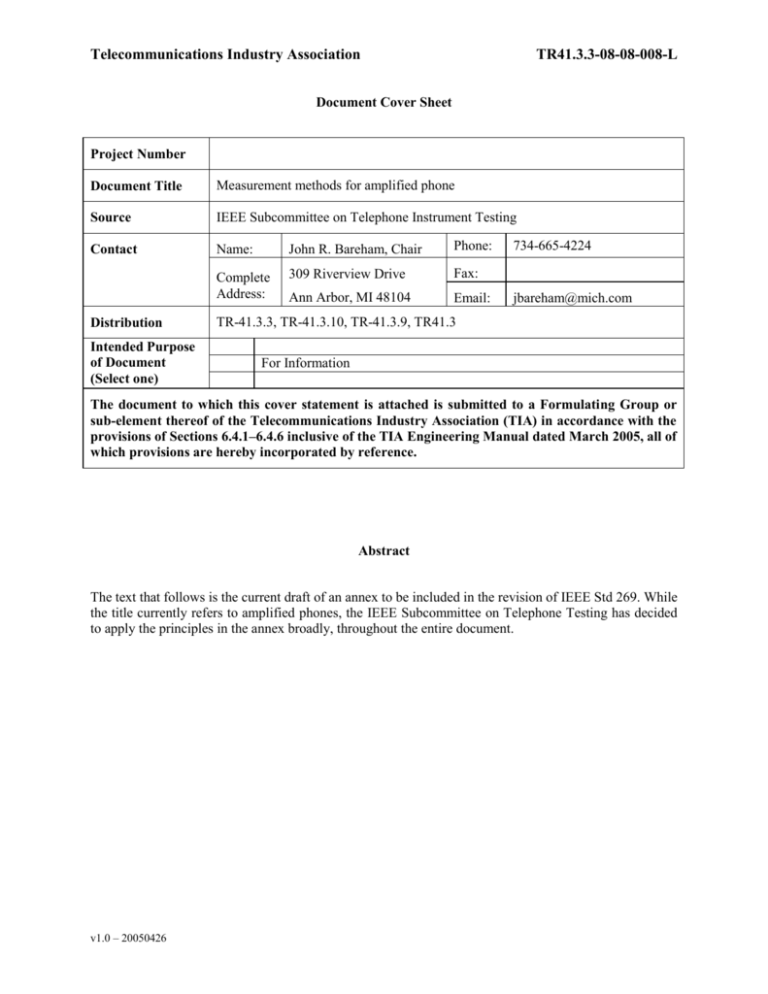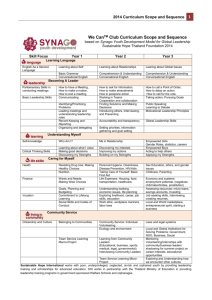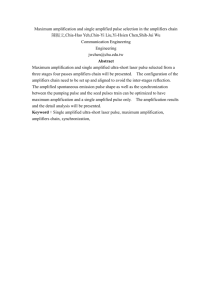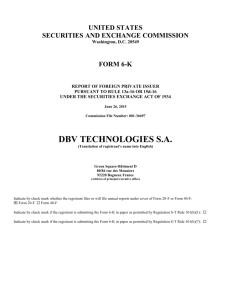TR41.3.3-08-08-008-L-MeasurementMethodsForAmplifiedPhones
advertisement

Telecommunications Industry Association TR41.3.3-08-08-008-L Document Cover Sheet Project Number Document Title Measurement methods for amplified phone Source IEEE Subcommittee on Telephone Instrument Testing Contact Name: John R. Bareham, Chair Phone: Complete Address: 309 Riverview Drive Fax: Ann Arbor, MI 48104 Email: Distribution Intended Purpose of Document (Select one) 734-665-4224 jbareham@mich.com TR-41.3.3, TR-41.3.10, TR-41.3.9, TR41.3 For Information The document to which this cover statement is attached is submitted to a Formulating Group or sub-element thereof of the Telecommunications Industry Association (TIA) in accordance with the provisions of Sections 6.4.1–6.4.6 inclusive of the TIA Engineering Manual dated March 2005, all of which provisions are hereby incorporated by reference. Abstract The text that follows is the current draft of an annex to be included in the revision of IEEE Std 269. While the title currently refers to amplified phones, the IEEE Subcommittee on Telephone Testing has decided to apply the principles in the annex broadly, throughout the entire document. v1.0 – 20050426 Telecommunications Industry Association TR41.3.3-08-08-008-L The text below is the current draft of an annex to be included in the revision of IEEE Std 269. Annex A (normative) Measurements on telephones with amplified receivers* *Needs new title, since it has been decided to apply these concepts generally throughout IEEE 269. A.1 Amplified telephones Telephones with amplified receivers are often marketed as “amplified telephones.” Strictly speaking, all telephones are amplified. Nevertheless, the terms “amplified phone” or “amplified receiver” generally are used to describe a telephone device which has more than the usual or “standard” gain in the receive path. These devices are generally marketed to persons with some degree of hearing loss. Telephones with amplified receivers are often compared to ordinary telephones with respect to amplification or gain. They are also compared with respect to frequency response characteristics such as high-frequency boost. The use of real or “reference” telephones is specifically not recommended for these purposes. Instead, this clause provides absolute references and metrics so comparisons can be made in a well-defined objective manner that relates to actual face-to-face conversations. The reference for level for comparison is 60dBSPL (unweighted) in the free field. (Under study now. Could be any number from 59-65 dBSPL. 64dBSPL is a likely candidate.) This is approximately the normal level of a face-to-face conversation between two people 1 meter apart, in a quiet room without reverberation. The reference for frequency response is a flat characteristic in the free field. This clause applies to handset or headset receivers. The subject of measurements on amplified phones continues to be under study. The methods in this clause may be subject to revision. A.2 Acoustic output level The acoustic output level at the receiver is strongly related to loudness, so it is a simple measure of the quantity of sound delivered to the ear. Acoustic output level is especially useful when comparing different kinds of communication equipment to each other, or when comparing a telephone conversation to a real face-to-face conversation. Page 2 of 5 Telecommunications Industry Association TR41.3.3-08-08-008-L Receive loudness rating (RLR) is the traditional way comparisons have been done in the telephone industry. RLR is the method generally accepted in the telecom industry for describing how the receive sensitivity and frequency response relate to the level of signals in the network. Loudness ratings are most valid when comparing phones of similar type, but they are less valid when comparing phones of very different designs. RLR does relate to face-to-face conversations, but only indirectly, through the medium of a defined “reference telephone.” It is seldom obvious to anyone outside the telecom industry how to interpret the meaning of an RLR, or how to compare it with a level or sensitivity measurement. To measure the acoustic output level, apply the test signal at the RETP. Measure the active total SPL at the receiver, translated to the free field, using the translation data in IEEE 1652. The test signal is real speech (Male conversational speech per IEEE Std. 269). The measurement shall be averaged over the entire length of the test signal, excluding pauses or silences. The measurement bandwidth shall be the same as the applied test signal, nominally 100-8500 Hz. Volume control shall be set to maximum. For an analog phone, the test signal levels at the RETP shall be: Loud: -14 dBV with 0 km loop Nominal: -25 dBV with 2.7 km loop Quiet: -38 dBV with 4.6 km loop A.3 Conversational gain The conversational gain of a receiver expresses the difference in level between a face-to-face conversation at 1 meter and a conversation using a telephone. The face-to-face conversation is assumed to be in a reflection-free and quiet environment, using both ears. The telephone conversation is assumed to use a handset or headset on one ear, in an environment which may be noisy. Conversational gain is dependent on both the volume control setting and the incoming signal level. By this definition, virtually all telephones have some conversational gain under some conditions. A standard phone might have a conversational gain in the range of 0dB for low levels of incoming signal at reference volume control setting, and up to 40dB for high levels of incoming signal at maximum volume control setting. An amplified phone is intended to provided high amounts of conversational gain under a wide range of incoming signal levels. When this is achieved, a listener with a hearing loss is more likely to be able to hear most conversations. The conversational gain of a receiver is defined as follows: Page 3 of 5 Telecommunications Industry Association TR41.3.3-08-08-008-L Conversational Gain = Acoustic output level in dBSPL (free field) – 60dBSPL (May change to 64dBSPL.) Acoustic output level shall be measured according to A.2. For an analog phone, the (active) test signal levels at the RETP shall be: Loud: -14 dBV with 0 km loop Nominal: -25 dBV with 2.7 km loop Quiet: -38 dBV with 4.6 km loop The conversational gain at all three test signal levels should be reported. Page 4 of 5 Telecommunications Industry Association TR41.3.3-08-08-008-L A.4 Frequency response metrics The general shape of the receive frequency response can be described in a way that relates to the overall spectral balance of the sound at the receiver. Most phones have significant response in the middle of the telephone band. They may or may not have significant response in the high frequency or low frequency parts of the telephone band. By comparing the low, middle and high-frequency parts of the response with the full bandwidth, it is possible to approximately describe spectral balance with 3 numbers, called low frequency balance, mid frequency balance and high frequency balance. If a receiver has a relatively natural-sounding frequency response, all three metrics will have values near zero (either plus or minus). If the low frequency balance value is negative by several dB, the receiver sounds thin. If the high frequency balance value is negative by several dB, the receiver sounds dull. If the mid frequency balance is positive by several dB, and the low and high frequency balance values are negative, this indicates a phone with most of its response in a narrow middle part of the telecom bandwidth. (This shape is sometimes referred to as a “haystack.”) To calculate these frequency response metrics, the receive frequency response should be measured in 1/3rd octave band resolution, from 250-3150 Hz. Portions of the frequency response curve should be averaged on a dB basis, in the following frequency ranges: Wideband average = (FR250 + FR315 + … + FR3150)/12 Low frequency average = (FR250 + FR 315 + FR 400 + FR500)/4 Mid frequency average = (FR800 + FR 1000 + FR 1200)/3 High frequency average = (FR2000+ FR 2500 + FR 3150)/3 Where FR250 = receive frequency response in the 250 Hz band, FR315 = receive frequency response in the 315 Hz band, Etc. Low frequency balance = Low frequency average – Wideband average Mid frequency balance = Mid frequency average – Wideband average High frequency balance = High frequency average – Wideband average A.5 Distortion Distortion shall be measured using the PN-SDNR method. At a minimum, the following frequencies should be tested: 400 Hz, 1000 Hz, and 2000 Hz. (tentative). The tests should be performed at several levels, at least including -14dBV with no loop. Page 5 of 5






